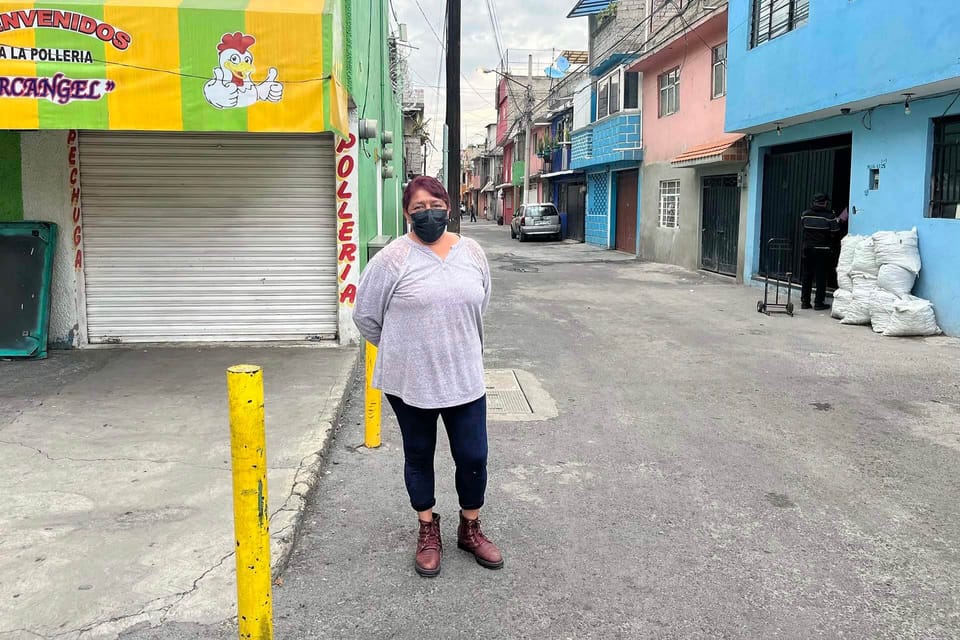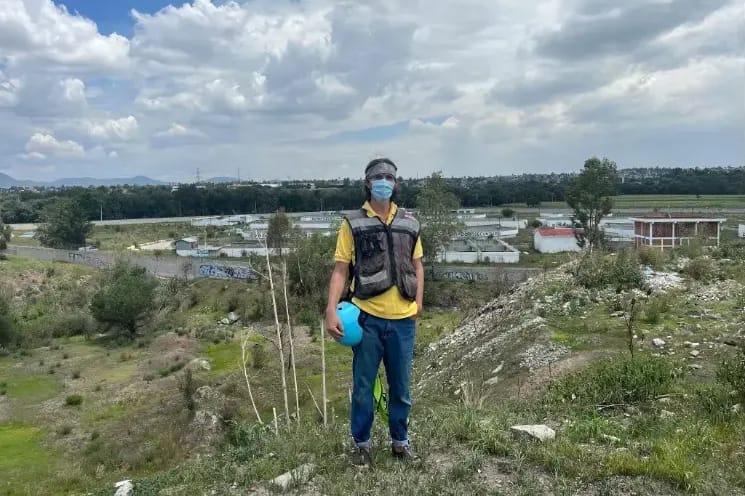The heroism of local climate activists in Mexico City

In the heart of bustling Mexico City, a silent catastrophe inches closer: the looming water crisis. As the world remains largely oblivious and the government is slow to act, a resilient group of individuals rises to the challenge, to restore water bodies and ensure water security, writes Claire Potter.
In Mexico City, even when water shortage looms, ‘Day Zero’ has been on the horizon for so many years that for many it is too easy to ignore. Gardeners still water lawns at the main university’s campus, fountains flow outside shopping centres in the wealthy neighbourhood of Polanco, and cranes strain their necks over already dense blocks as developers keep building in the resource-strained city.
Compared to the social and economic problems in Mexico, environmental challenges can seem like a distant threat.
Gabriel, my local reporting partner, had hours to chat as we sat in Mexico City’s traffic on our way to Iztapalapa, a sprawling neighbourhood where clean water is scarce and thousands of homes have no running water. It was a break to help with ‘a nice story’ for a change, he told me. Though the water crisis poses an existential threat to the city, ‘nice’ wasn’t the word that came to mind. Yet, I understood his point. He and his partners work with foreign journalists who almost always want to cover narcos. Violence ensnares Mexico. The official count of missing people exceeds 100,000, a number that rivals a civil war. Violence and slow economic growth perpetuate the poverty of millions.
At times, reporting on the water crisis in Mexico was demoralizing. Innovative ideas to solve the problem are abundant, but the means to implement them are elusive. People familiar with the crisis explained that corruption stymies infrastructure projects that could move the city towards a sustainable water system and endangers the conserved land that is so important for aquifer filtration and water storage. Yet again and again, I met people who decided to shoulder the responsibility for a problem far bigger than themselves.
Daniel Dultzin is a former ambassador who represented Mexico in Ireland and France. He reapplied his diplomatic know-how to environmental issues after retirement. Mexico has to prioritise the environment because it’s a question of survival, he argues.
I focused my reporting on Mexico City, a megacity of about over 22 million, but the water crisis is nationwide. To the north, the industrial city of Monterrey already ran out of water once in 2022. Decades of extraction compounded by climate change put water supplies at risk all over the country. Lax environmental laws and intermittent enforcement have left the majority of Mexico’s rivers contaminated. The most polluted stink of industrial waste and sewage.
Dultzin dedicates himself to spreading the ideas of Kongjian Yu, a Chinese landscape architect who strives to recover the natural movement of water through cities. He wants to heal China’s water systems, ungirding rivers from narrow concrete channels and incorporating wetlands and floodplains into urban planning.
Now, Dultzin is an ambassador for the possibilities of a ‘green and blue’ city – an urban environment that integrates nature, clean waterways and open space. He invited Yu to give a series of lectures in Mexico City to help his city envision solutions. He constantly tries to spread the gospel of ecological urbanism with events, lectures and articles – anything to get more people to understand the urgency of the problem and see that there are solutions. Books on water management and the ecological history of Mexico line the walls of his airy apartment in Juarez, a fashionable neighbourhood in Mexico City where he has lived longer than it has been fashionable. He recently hired an artist to paint a blue, watery mural in his courtyard.
“You have to understand,” he tells me. “What sustains us, what keeps us living is nature.”
Liliana Espindola Ramirez, like most households in her neighbourhood, depends on deliveries from water trucks because her family does not have running water. She sells food in a street market in Iztapalapa, but she is better known as an elected community leader in her neighbourhood. She worked with other women to organise about 500 families to streamline water deliveries. Families communicated to her and the other women how much water they needed and when. Then, the women communicated what they needed to the local government. Ramirez called repeatedly or turned up at municipal offices if the water did not come.
In the north of Mexico City, a dedicated group of scientists, urban planners, engineers and biologists have donated millions of pesos worth of their time to gather the necessary data to apply for funding from the Green Climate Fund to clean up Laguna de la Piedad, also known as Lagoon of Mercy.


Left: Gustavo Schinca, an environmental activist, stands in front of a water treatment plant near Laguna de la Piedad. Right: brown rivulets of untreated sewage trickle into Laguna de la Piedad. The lake faces threat from pollution and encroachment. Photos: Claire Potter
At Laguna de la Piedad, I also met Gustavo Schinca, an intense man who adopted the lake restoration as his mission. The polluted lake stinks with the sewage of surrounding neighbourhoods. He lives just a few miles away near another lake, Espejo de los Lirios, where the water is clean, feeds abundant wildlife and attracts families and tourists. He wants Laguna de la Piedad to be another Espejo.
“It was an idea, something quixotic, like Don Quixote, of launching an impossible mission to save the world,” he says.
Schinca is incredulous that large and expensive treatment plants were built near the lake, but languish in disuse because a simple water collector system has not been completed. Schinca pressures the government to treat the sewage so that the lake can transform into a haven for wildlife and a hub of ecotourism. He predicts that getting the system working may take 10 to 15 years, and he plans to keep fighting for it.
Schinca cut his work as a statistics researcher down to part-time so that he could focus on the environmental work he feels matters more. He and his wife agreed not to have children. Children, he explains, would distract them from the environmental cause and only contribute to the broader problems.
The native people of San Gregorio, a centuries-old town that was swallowed into the city, lost both their water and their heritage when they lost their relationship to water, says Lourdes Granado. Her family has farmed in San Gregio for generations. It is part of Xochimilco, a neighbourhood that is home to both dense working-class urban blocks and a precious wetland preserve.

“They (our ancestors) had water, they had earth, they had lush vegetation, a great amount of biodiversity, of fauna and flora. We have lost this,” says Granado. The city centre extracted water from the abundant aquifers of Xochimilco and sucked water out of its springs. The damage was so severe that the preserved wetlands depend on filtered wastewater rather than the springs that once filled them.
Xochimilco was once a rural farming community where Mexican photographers went to capture a way of life that survived the modernisation that rushed through the city centre. Its chinampas, a form of agriculture where canals irrigate small plots of fertile land, have seen little change over the centuries. Now, much of the vast neighbourhood is concrete and crowded. The Xochimilco wetlands preserve, itself a UNESCO World Heritage Site, is an abundant remnant of the canals and chinampas that once occupied far more land. It is also a valuable environmental resource for Mexico City as it moderates temperatures. Yet, the preserve is under threat from development and pollution.

Granado’s grandfather died in 2008, and her family’s chinampas fell into disuse without his care. After generations of farming, her grandparents had urged their children to go to school and work for wages. Farming was suffering. They lived by the whims of lightning, storms and drought. Now, her family boasts doctors, engineers and teachers. Their family’s story is a common one in Xochimilco, and is part of why chinampas are disappearing, she explains.
But as the family gained social mobility, they lost some of their heritage, Granado says. And no one had the time or skill to cultivate the chinampas. She and her uncle, both retired from education, are resuscitating them. Reviving a chinampa is hard, manual labour, especially because they do not use any toxic fertilisers or pesticides. But it is important work not just for Granado’s family, but also for the city that depends on the wetlands’ ecological benefits and the abundant flora and fauna that rely on the habitat. Granado invites families to bring their children to the chinampas to plant seeds. As they sew the seeds, she hopes they will grow up to fight for the wetlands that remain.
The more I learned about Dultzin, Schinca, Granado and many others I had the chance to speak to in Mexico, the more their resolve struck me. They were frustrated by government inaction and corruption, but that only pushed them to do more. They did not hesitate to work for free if that is what it would take to make progress. Their generosity toward me mirrored their dedication to their cause. They were patient with my imperfect Spanish, and they were eager to lend me books, connect me with more people, and give me their time.
This story was originally supported and published by the Pulitzer Center.



Member discussion